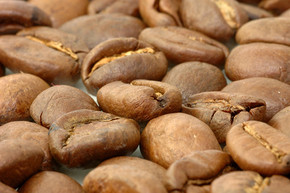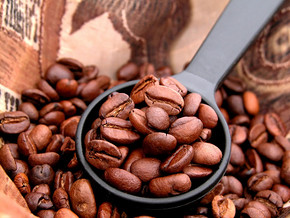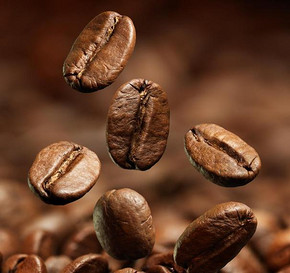The story and history of Kona coffee beans in Hawaii
Follow the caf é (Wechat official account vdailycom) and found that Beautiful Cafe opened a small shop of its own.
Legend has it that the volcano goddess Pele fled to the Big Island of Hawaii after losing a love dispute. With a bad temper, she often gets angry, so the volcano on the big island is still erupting to this day. Affected by this, the soil in Kona Oshima has moderate acidity and is rich in minerals. Coupled with the warm and humid climate, Kona Coffee is unexpectedly one of the top three in the world.
There are currently more than 600 coffee farms in the Kona area. These farms are concentrated on the hillside of the volcano at an altitude of 800 to 3000 feet, forming a unique "coffee belt". Every March, the coffee tree will appear white flowers, flowering for only two or three days, each flower means a fruit. Kona Coffee has the most beautiful fruit in the world, full in shape, bright in color and bright in luster. There is no time-saving and labor-saving way to collect these fruits, only to rely on hard workers to pick them by hand.

Each fruit contains two seeds, which are what we usually call coffee beans. 15 pounds of coffee fruit produces only 2 pounds of beans. If the two seeds grow together, they become the more precious "Peaberry" coffee, accounting for only 5 per cent of the total coffee production. Every afternoon, farm workers bag the collected fruit back to the factory, peel, wash, air, and then bake for different lengths of time to become Kona coffee with a variety of flavors.
Greenwell Farms is the oldest coffee farm in Kona. Since Henry Nicolas Greenwell left England for the Big Island in 1850, his family has been in the coffee industry here for more than 160 years. In the 1990s, when the farm was on the verge of closure, the current owner, Tom Greenwell, nearly abandoned the family business. Finally, with the introduction of advanced business concepts and planting techniques, as well as some seemingly incredible methods, the farm prospered again. Today, they still insist on pruning those coffee trees that have borne fruit to a height of 50 centimeters after a bumper harvest, so that they will get a greater harvest in the future. The farm's most recent award-winning coffee is called Jeni.K, which comes from carefully cultivated coffee trees in the Konanaewa area of the farm. This coffee shows a perfect tropical flavor: a fresh palate with intense fruit guava aromas and a hint of vanilla and chocolate. Jeni.K Q is taken from the farm hostess's name Jennifer, so the package is printed with a blooming rose. The aroma of coffee curled up, and the farmer's affection drifted far away.
Through its aroma and taste, people who have tasted Kona Coffee say it has a mixture of smoky, fruity and earthy aromas, and is more likely to feel the original taste before grinding. At present, the coffee served by the White House on important occasions is also Kona Coffee. But the growers and producers of Kona Coffee will directly tell all the admiring tourists to give up the etiquette on the coffee table, taste every sip of coffee, feel the rich taste in the mouth, and let the coffee talk to you. In this season, let a cup of Kona coffee bring distant Hawaii to you and melt the whole autumn.
Important Notice :
前街咖啡 FrontStreet Coffee has moved to new addredd:
FrontStreet Coffee Address: 315,Donghua East Road,GuangZhou
Tel:020 38364473
- Prev

The origin of coffee in Hawaii, the grading of Kona coffee
Following Cafe (Wechat official account vdailycom) found that the good Cafe opened a small shop in Hawaii (Hawaii) after nearly two centuries of efforts to grow coffee, the term Kona has almost equated with "quality". Hawaii has superior planting conditions, but historically, coffee trees have been introduced for the first time since 1825.
- Next

Description of taste and flavor of Costa Rican coffee beans in Goddess Manor
Following Cafe (Wechat official account vdailycom) found that the Beautiful Cafe opened a small shop of its own [introduction] the Dota region, located in the best-known tarrazu region of Costa Rica, is famous for producing micro-batch varieties of geisha! in 1865, the Dota area enjoyed the reputation of good Costa Rican coffee because of the need for highway construction extending from the capital to the Dota Valley.
Related
- Detailed explanation of Jadeite planting Land in Panamanian Jadeite Manor introduction to the grading system of Jadeite competitive bidding, Red bid, Green bid and Rose Summer
- Story of Coffee planting in Brenka region of Costa Rica Stonehenge Manor anaerobic heavy honey treatment of flavor mouth
- What's on the barrel of Blue Mountain Coffee beans?
- Can American coffee also pull flowers? How to use hot American style to pull out a good-looking pattern?
- Can you make a cold extract with coffee beans? What is the right proportion for cold-extracted coffee formula?
- Indonesian PWN Gold Mandrine Coffee Origin Features Flavor How to Chong? Mandolin coffee is American.
- A brief introduction to the flavor characteristics of Brazilian yellow bourbon coffee beans
- What is the effect of different water quality on the flavor of cold-extracted coffee? What kind of water is best for brewing coffee?
- Why do you think of Rose Summer whenever you mention Panamanian coffee?
- Introduction to the characteristics of authentic blue mountain coffee bean producing areas? What is the CIB Coffee Authority in Jamaica?

